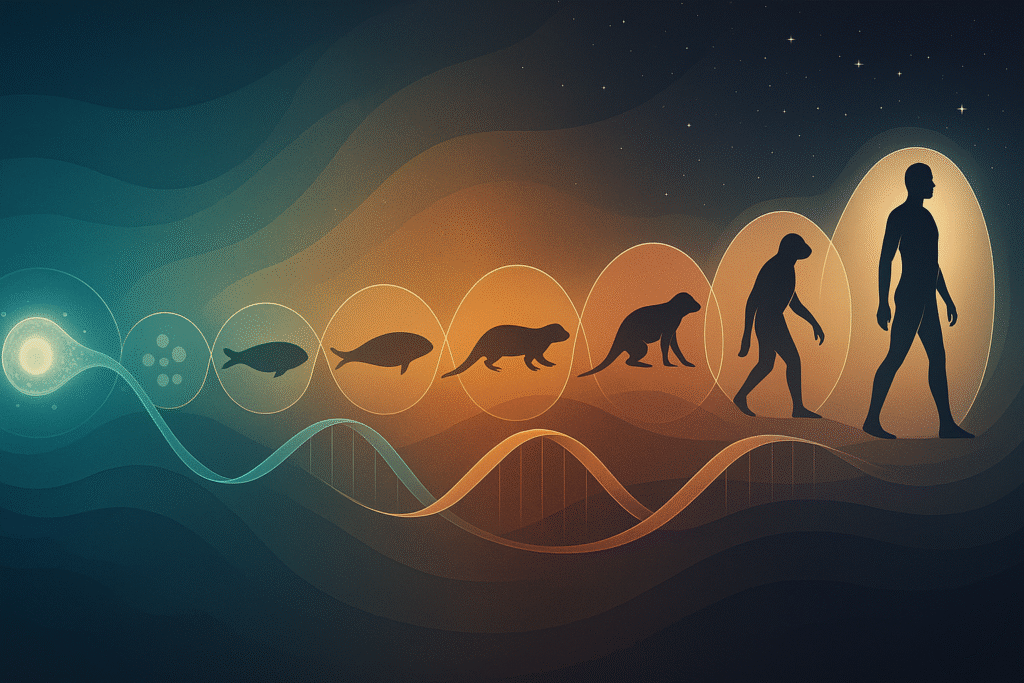Humans did not “come from the monkeys alive today.” Humans and other primates (chimpanzees, gorillas, etc.) share common ancestors—ape-like species that lived ~6–7 million years ago. Multiple independent lines of evidence (fossils, dating, genetics, anatomy, archaeology) converge on the same story: our species Homo sapiens arose in Africa ~300,000 years ago and later dispersed worldwide, interbreeding with close cousins (Neanderthals/Denisovans). This is not “made up”; it’s a large, testable scientific framework that keeps predicting new, correct details. (Human Origins, Science)

What “we didn’t evolve from monkeys” actually means
- Today’s monkeys and humans are cousins, not ancestor-and-descendant. We both descend from earlier primates; chimpanzees are our closest living relatives, with divergence estimates around 6–7 million years ago. (Human Origins, PMC)
Fossil record: step-by-step changes
Key fossils show a mosaic of human and ape-like features over time:
- Sahelanthropus tchadensis (Chad, ~7–6 Ma): very early hominin; recent analysis supports habitual bipedalism. (Nature)
- Ardipithecus ramidus (“Ardi”, Ethiopia, 4.4 Ma): pelvis/foot show upright walking capability plus tree-climbing traits. (Science, Human Origins)
- Australopithecus afarensis (“Lucy”, Ethiopia, 3.2 Ma): clear bipedal anatomy; small brain—showing walking upright preceded big brains. (Human Origins, Wikipedia)
- Homo erectus (~1.9 Ma–143 ka globally): larger brains, long-distance walking, hand axes; Indian specimen from Narmada ~300 ka. (Human Origins)
- Homo sapiens (our species): oldest well-dated fossils at Jebel Irhoud, Morocco, ~315 ka, with a blend of modern and archaic traits. (Science)
How we know the ages: volcanic layers and sediments are dated by radiometric methods (e.g., ⁴⁰Ar/³⁹Ar, K–Ar), U-series, ESR, plus paleomagnetism and luminescence—standard tools in human-origins research. (Human Origins, PubMed, PNAS)
Genetics: powerful, independent confirmation
- Humans and chimps share extensive DNA homology (roughly ~98–99% in coding regions; genome-wide divergence near ~1.2%). The pattern of shared mutations nests humans within African apes—exactly what common ancestry predicts. (PMC, BioMed Central)
- Human Chromosome 2 is a textbook prediction: humans have 46 chromosomes vs 48 in other great apes because two ancestral chromosomes fused head-to-head. At the fusion site you can still see telomere-to-telomere remnants and a vestigial, inactivated centromere—documented at base-pair level. (PMC, BioMed Central)
- Endogenous retroviruses (ERVs) and pseudogenes (e.g., the broken GULO vitamin-C gene) sit in the same genomic locations in humans and other primates—shared genetic “typos” that are vanishingly unlikely without common ancestry. (PMC, PubMed)
Behavior & archaeology
- Stone-tool traditions show cognitive and cultural change: Oldowan → Acheulean → Middle Paleolithic → Upper Paleolithic. In India, Attirampakkam (TN) shows Middle Paleolithic technology by ~385–172 thousand years ago (luminescence-dated), reframing South Asian timelines. (Nature, PubMed)
- Out-of-Africa dispersal: most genetic/archaeological syntheses indicate major expansions ~70–60 ka, with earlier excursions in some regions. (Nature, PMC)
- As our species spread, we interbred with Neanderthals and Denisovans; some introgressed genes affect immunity and traits today. (PMC, eLife)
India highlights (sites & finds)
- Narmada (Madhya Pradesh): partial Homo erectus calvarium, ~300,000 years. (Human Origins)
- Attirampakkam (Tamil Nadu): early Middle Paleolithic stone tools from ~385 ka onward—very early for South Asia. (Nature)
- Dhaba (Middle Son River, MP): continuous occupation ~80–65 ka, spanning the Toba super-eruption. (PMC)
- Bhimbetka (Madhya Pradesh): rock art and occupations extending back to the Late Paleolithic/Mesolithic—evidence of complex symbolic behavior. (Encyclopedia Britannica)
So…fact or “made up”?
A scientific idea is strong when independent lines of evidence agree and when it predicts new findings. Human evolution passes both tests:
- Fossils chronologically line up with anatomical transitions. (Science, Human Origins)
- Dating methods from physics corroborate the sequence. (Human Origins)
- Genomes retain the history (chromosome-2 fusion, ERVs, shared mutations). (PMC)
- Archaeology and ancient DNA show migrations and interbreeding that match genetic predictions. (PMC)
This is why there’s an overwhelming scientific consensus that humans evolved via common ancestry within primates.
Quick FAQ you can quote
- “Did we come from chimps?” No—we share an ancestor with chimps; neither came from the other. (Encyclopedia Britannica)
- “When did Homo sapiens appear?” Best current fossils: ~315,000 years (Jebel Irhoud, Morocco). (Science)
- “One big migration or many?” Multiple waves likely; a major global expansion occurred ~70–60 ka, with region-specific complexities. (Nature)
- “Is there Indian evidence?” Yes—Narmada, Attirampakkam, Dhaba, Bhimbetka are key. (Human Origins, Nature, PMC, Encyclopedia Britannica)


